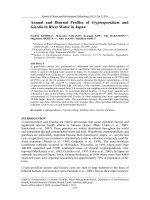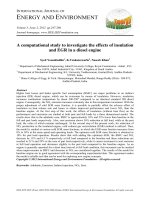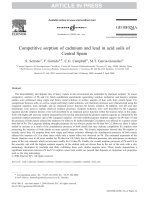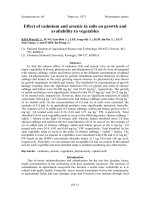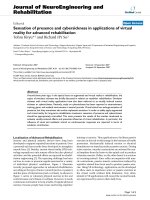Development of an alpha fast-slow coincidence counter for analysis of 223Ra and 224Ra in seawater
Bạn đang xem bản rút gọn của tài liệu. Xem và tải ngay bản đầy đủ của tài liệu tại đây (413.83 KB, 5 trang )
Nuclear Science and Technology, Vol.8, No. 3 (2018), pp. 09-13
Development of an alpha fast-slow coincidence counter for
analysis of 223Ra and 224Ra in seawater
Chau Thi Nhu Quynh, Pham Ngoc Tuan, Tran Anh Khoi and Tuong Thi Thu Huong
Nuclear Research Institute, 01 Nguyen Tu Luc, Dalat, Lam Dong
Email:
(Received 10 October 2018, accepted 3 December 2018)
Abstract: An alpha fast-slow coincidence counter has been designed and manufactured for measuring
the low alpha activities of 223Ra and 224Ra in the seawater. In this work, Radium from the seawater
was absorbed onto a column of MnO2 coated fiber (Mn fiber). The short-lived Rn daughters of 223Ra
and 224Ra which recoil from the Mn fiber are swept into a scintillation detector where alpha decays of
Rn and Po occur. Signals from the detector are sent to a delayed coincidence circuit which
discriminates decays of the 224Ra daughters, 220Rn and 216Po, from decays of the 223Ra daughters, 219Rn
and 215Po.
Keywords: Low alpha counting system, analysis of 223Ra and 224Ra.
I. INTRODUCTION
Giffin et al. (1963) developed a highly
sensitive system for the measurement of 219Rn
and 220Rn by determining the delayed
coincidence counting of the rare gas products
of 231Pa [1]. Based on the Giffin’s design, a
similar system has been developed in the Dalat
Nuclear Research Institute in order to measure
223
Ra and 224Ra in coastal water.
The counting system functioned based
on the detection of alpha particles from the
decaying scheme 223Ra, 224Ra and daughters
shown in Fig. 2.
The delayed circuits were established in
order to open and close the gates following the
decay times of Rn, about four half-lives of Po [2].
By employing the method of conceptual
analysis, an alpha fast-slow coincidence
spectrometer has been designed and
manufactured in the Dalat Nuclear Research
Institute. This system is used for the low alpha
activity analysis of 223Ra and 224Ra in seawater.
II. DESIGN AND MANUFACTURE
The block diagram of the alpha fast-slow
coincidence counter was shown in Fig. 1.
Fig. 1. Schematic diagram of the delayed coincidence circuit.
©2018 Vietnam Atomic Energy Society and Vietnam Atomic Energy Institute
DEVELOPMENT OF AN ALPHA FAST-SLOW COINCIDENCE COUNTER FOR ANALYSIS…
The detector was fabricated from a
sealed plexiglass chamber. The silver-activated
zinc sulfide ZnS(Ag) is used as a scintillator
[3]. It was coated on the internal surface of the
chamber wall in order to optimize the
efficiency of detecting an emitted radiation.
The volume of the chamber is 1.7 L. A
scintillation
detector
coupled
to
a
photomultiplier tube (PMT) R877 of
Hamamatsu [4]. The signals from PMT were
sent to an amplifier and analyzed by a delayed
coincidence circuit which includes of a
buffer/timer, microcontrollers and connected to
the PC via the RS-232 interface. The above
circuits are designed using the Xilinx ISE 10.1
toolkits and programmed by C++Builder
language [5-7].
When a Rn nuclear decays, an alpha
particle is emitted. If this alpha particle interacts
with ZnS(Ag) of sealed chamber, it will create
photons. The PMT obtained the photons and
formed electronic pulses. The output signals
must be shaped and amplified by a shaping
amplifier and then converted into logic pulses.
A counter system analyzes the decay time of
each pair of radon-polonium following the
decay scheme shown in Fig. 2. [NuDat 2.7]
Fig. 2. Simplified decay scheme of 223Ra and 224Ra.
gate time of 5.6ms (3T1/2 of 215Po) and the
channel 3 (Ch#3) is used to obtain total counts
during the measuring time. A block diagram of
220
Rn channel and a timing diagram for 3 counter
channels are presented in Fig. 3 and Fig. 4.
The delayed coincidence circuit contains
three separated counter channels. The slow
channel 1 (Ch#1) is to measure 224Ra during the
gate time of 600ms (4T1/2 of 216Po); the fast
channel 2 (Ch#2) is to determine 223Ra during the
Fig. 3. Block diagram for 220Rn channel.
10
CHAU THI NHU QUYNH et al.
Fig. 4. Timing diagram for 3 counter channels.
The production of decay from 219Rn to
215
Po is also fed to the Ch#2 and delayed for
10ms. At that time, the 220Rn circuit opens for
600ms. If a signal occurs while this gate is
opened, it is recorded in the 220Rn channel [2].
The final adjustment must be made to
the 220Rn data due to 219Rn and its daughter. If
two 219Rn decays occur while the 220Rn
window is open, the second 219Rn decay of
215
Po will be recorded in the 220Rn channel [2].
We designed a complete count system
shown in Fig. 5.
The alpha particle detected in the
scintillation chamber produces a signal and
registered by a delayed coincidence channels
(see Figure 1). For Ch#1, the signal is delayed
for 0.15ms to allow the circuit to stabilize. The
signal opens a gate during the time interval of
5.6ms. Any second count detected in this
period time is recorded in the 219Rn channel.
The count itself is most likely due to 215Po
decay, but, it would have been unrecorded if a
decay of 219Rn had not opened the gate within
the prior 5.6ms.
Fig. 5. A complete count system.
generator was used as an input pulse for the
amplifier discriminator. The TTL logic pulse from
its output was counted by three counter channels
during the gate times as shown in Fig. 4.
III. TESTING MEASUREMENT
Set up for the experiment is shown in
Figure 6. The exponential decay pulse with
frequency approximate 986 ± 1(Hz) from the DB2
11
DEVELOPMENT OF AN ALPHA FAST-SLOW COINCIDENCE COUNTER FOR ANALYSIS…
When the system starts measuring, Ch#1
and Ch#2 wait for a first input pulse of 10µs to
open the gates. Ch#1 measured all events
during the gate time of 5.6ms while Ch#2
obtained the events at the gate time of 600ms.
The circuits were repeated continuously until
stopping measurement. Total counter channel
measured all events in the preset time tm.
Fig. 6. Schematic diagram of testing setup.
Estimated count (EC) of each channel
could be calculated by the following semi
empirical formula:
)
[(
]
(
- Total count get on total counter channel.
In this test measurement, the gate time
for
Rn is 5.6ms while the gate time for
220
Rn is changed from 600ms to 900ms in
order to evaluate the counts detected from
each channel. The obtained results showed
that the differences between measured and
estimated values are 3.5% and 0.3% for 219Rn
and 220Rn, respectively. The standard
deviation is less than 0.2% for different
measurements. The measured and estimated
counts obtained from each counter channel are
presented in Table I.
219
)
where:
- tm: preset time (100s);
- tw: waitting time (10µs for
10ms for 220Rn);
219
Rn and
- tG: gate time;
- CR: count rate, CR = Total count/tm;
Table I. Comparison of measured and estimated counts of 219Rn and 220Rn.
220
219
Rn
Rn
Gate
time
219
Rn
(ms)
Gate
time
220
Rn
(ms)
Total
count
5.6
600
5.6
Measured
counts
Estimate
counts
Relative
deviation
(%)
Measured
counts
Estimatedc
ounts
Relative
deviation
(%)
98761
82300
79484
3.54
97270
96962
0.30
700
98773
82310
79496
3.54
97492
97227
0.26
5.6
800
98558
82131
79285
3.59
97437
97205
0.23
5.6
900
98518
82098
79245
3.60
97516
97314
0.20
Mean
98653
82210
79378
97429
97177
Standard
deviation (%)
0.14
0.13
0.17
0.11
0.16
12
CHAU THI NHU QUYNH et al.
assay of actinon and thoron, J. Geophys. Res.,
68(6), 1749–1757, 1963.
III. CONCLUTIONS
The alpha coincidence counter with
three separated counter channels has been
designed and fabricated successfully in the
Dalat Nuclear Research Institute. The gate
times were set of 5.6ms and 600ms for fast
and slow channels, respectively. This system
has been used for analysis of 223Ra and 224Ra
in seawater.
[2]. Moore, W. S., and R. Arnold, Measurement of
223
Ra and 224Ra in coastal waters using a
delayed coincidence counter, J. Geophys. Res.,
101(C1), 1321–1329, 1996.
[3]. EJ-440 ZnS:Ag Phosphor sheet from ELJEN
Technology; www.eljentechnology.com
[4]. Photomultiplier tubes R877 from Hamamatsu
corporation company datasheets;
This alpha three channels counter has a
compact design and digital signal process.
This is a new trend to design electronic
devices because of a simple circuit design by
using FPGA.
www.hamamatsu.com
[5]. Xilinx, KPCSM3 PicoBlaze Processor
Reference Guide, Embedded Development Kit
EDK 10.1.
REFERENCES
[6]. Spartan-3E FPGA Starter Kit Board User
Guide; Website: www.xilinx.com
[1]. Giffin, C., A. Kaufman, and W. Broecker,
Delayed coincidence counter for the
[7]. ISE Design Suite 10.1 Release Notes and
Installation Guide; Website: www.xilinx.com.
13
